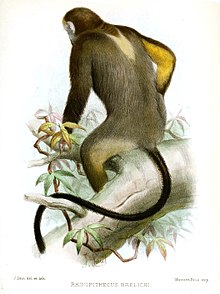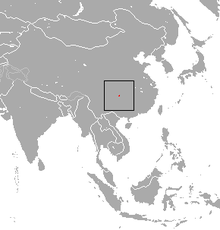| Gray snub-nosed monkey [1] | |
|---|---|

| |
|
Scientific classification
| |
| Domain: | Eukaryota |
| Kingdom: | Animalia |
| Phylum: | Chordata |
| Class: | Mammalia |
| Order: | Primates |
| Suborder: | Haplorhini |
| Infraorder: | Simiiformes |
| Family: | Cercopithecidae |
| Genus: | Rhinopithecus |
| Species: | R. brelichi
|
| Binomial name | |
| Rhinopithecus brelichi
Thomas, 1903
| |

| |
| Gray snub-nosed monkey range | |
| Synonyms | |
|
Pygathrix brelichi Thomas, 1903 [3] | |
The gray snub-nosed monkey (Rhinopithecus brelichi), [1] also known as Brelich's snub-nosed monkey, Guizhou snub-nosed monkey, and Guizhou golden monkey, [4] is a species of primate in the family Cercopithecidae. [1] [2] It is endemic to China, [1] where it is known as the Guizhou golden hair monkey (黔金丝猴) or gray golden hair monkey (灰金丝猴). [4] It is threatened by habitat loss. [2] Of the three species of snub-nosed monkeys in China, the gray snub-nosed monkey is the most threatened, with a total population thought to number fewer than 400 individuals. [5]
Description
Adults are covered with long, fine hair, generally grading from brown on its upper body to gray on its lower body, with a white patch between its shoulder blades. [6] Its head, neck, and ends of its limbs are black, except for a golden brow. [6] It has a golden chest, and chestnut fur on its inner knees and inner sides of its upper arms. [7] Its face is bare bluish-white skin, pink around the eyes and mouth, and has a shelf-like brow and reduced nasal bones, giving it a snub-nosed appearance. [6] [7] Juveniles are shades of gray with patterns changing with age. Adult males are brighter colored than adult females, and have white skin on prominent nipples. [6] Size data is limited, but two adult male specimens weighed 14.5 kg on average, and an adult female specimen weighed 8 kg, with adult length excluding tail ranging from 64–73 cm, and tail length ranging from 70–97 cm. [6] [7]
Distribution
The confirmed distribution range of the gray snub-nosed monkey is limited to the Fanjingshan National Nature Reserve in the Wuling Mountains in Guizhou province, China. [4] There is unpublished evidence that 20 individuals moved from the Nature Reserve to an adjacent community forest (Lijiadashan), and there are unconfirmed anecdotal reports of a population in Jinfoshan Nature Reserve. [2]
Habitat
Its habitat consists of mixed deciduous and evergreen broadleaf forests, including secondary forest, but not coniferous forest. [8] [9] The forests include mono-groves of Asian oak ( Cyclobalanopsis spp.) and beech ( Fagus longipetiolata), as well as mixed species forests that include cherry ( Prunus spp.), maple ( Acer spp.), Rhododendron spp, and birch ( Betula spp.) trees. [6] It lives at elevations of 1,400–2,300 m in summers down to 570 m at times of heavy snow cover. [8] They are thought to utilize most of the available range of the nature reserve. The yearly rainfall in the area above 1,600 m elevation is above 2000 mm. Snow is common in the winter, with sub-freezing temperatures about five months of the year, though monthly mean temperatures are never below 0 °C. [6]
Behavior
The diurnal species is considered semi-terrestrial, primarily inhabits trees where available. [8] Locomotion includes a mix of "quadrupedal walking, climbing, leaping, semi-brachiation (tree-swinging) and occasional full brachiation." [6]
It feeds on a variety of young leaves, leaf and flower buds, bark, fruits, certain petioles (e.g. Fagus longipetiolata), seeds (e.g. Prunus spp. and Sorbus spp.), and insect larvae. [6] Seasonality of the forest means the monkey's diet changes seasonally as well; it may be 7% leaves in the first three months of the year, and 93% in the next three. Fruits and seeds can constitute 35% of the diet in July to September. [10]
Its social structure is based on small groups that band together into larger troops of up to 400 or more individuals, traveling, feeding and sleeping. [2] The groups typically have 5–10 members, comprising one dominant male and several females and their young. [6] There are also all-male bachelor groups of two to five adult or sub-adult males, which typically mill about the periphery of a troop. [6] The groups split into large or smaller bands seasonally. [2]
Conservation status
Though legally protected, the gray snub-nosed monkey is threatened seriously due to habitat loss from forest clearing, illegal mining, non-targeted hunting, and occasional inadvertent snare trapping. [2] [9] A 2008 census located around 750 individuals, consistent with a 2005 census. [2] [9] The estimated number was reduced in 2020 when a study on the remaining habitat estimated there may be as few as 125 to 336 individuals. [5] In 1978, the Fanjingshan National Nature Reserve was established, covering the entire range of the gray snub-nosed monkey, this area was subsequently designated a UNESCO Biosphere Reserve in 1986. [11] In 2018, Fanjingshan was designated a World Heritage Site composed of Fanjingshan National Nature Reserve, Yinjiang Yangxi Provincial Nature Reserve, and a small area of National Non-Commercial Forest. [12]
See also
References
- ^ a b c d Groves, C. P. (2005). Wilson, D. E.; Reeder, D. M. (eds.). Mammal Species of the World: A Taxonomic and Geographic Reference (3rd ed.). Baltimore: Johns Hopkins University Press. p. 174. ISBN 0-801-88221-4. OCLC 62265494.
- ^ a b c d e f g h Long, Y.; Li, B.; Zhou, J.; Ren, B.; Garber, A. L. (2022). "Rhinopithecus brelichi". IUCN Red List of Threatened Species. 2022: e.T19595A215621115. Retrieved 21 July 2022.
- ^ "Rhinopithecus brelichi". Integrated Taxonomic Information System. Retrieved 13 June 2021.
- ^ a b c "Common Names for Brelich's Snub-nosed Monkey (Pygathrix brelichi)". Encyclopedia of Life. Retrieved 16 December 2013.
- ^ a b Yanqing, Guo; Baoping, Ren; Qiang, Dai; Jun, Zhou; Garber, Paul A.; Jiang, Zhou (2020). "Habitat estimates reveal that there are fewer than 400 Guizhou snub-nosed monkeys, Rhinopithecus brelichi, remaining in the wild". Global Ecology and Conservation. 24: e01181. doi: 10.1016/j.gecco.2020.e01181.
- ^ a b c d e f g h i j k Renmei, Ren; Kirkpatrick, R. Craig; Jablonski, Nina G.; Bleisch, William V.; Canh, Le Xuan (1998). "Chapter 17: Conservation Status and Prospects of the Snub-nosed Langurs (Colobinae: Rhinopithecus)". In Jablonski, Nina G. (ed.). The Natural History of the Doucs and Snub-nosed Monkeys. Recent Advances in Human Biology. Vol. 4. World Scientific Publishing Co. Pte. Ltd. pp. 301–314. ISBN 978-981-02-3131-6. Retrieved 16 December 2013.
- ^ a b c "Grey snub-nosed monkey photo – Rhinopithecus brelichi – G42086". ARKive. Wildscreen. Archived from the original on 2013-12-16. Retrieved 16 December 2013.
- ^ a b c "Facts about Brelich's Snub-nosed Monkey (Pygathrix brelichi)". Encyclopedia of Life. Retrieved 16 December 2013.
- ^ a b c Xiang, Z.; Nie, S.; Lei, X.; Chang, Z.; Wei, F.; Li, M (2009). "Current status and conservation of the gray snub-nosed monkey Rhinopithecus brelichi (Colobinae) in Guizhou, China". Biological Conservation. 142 (3): 469–476. doi: 10.1016/j.biocon.2008.11.019. ISSN 0006-3207.
- ^ Bleisch, William V.; Jiahua, Xie (1998). "Chapter 11: Ecology and Behavior of the Ghizhou Snub-nosed Langur (Rhinopithecus [Rhinopithecus] brelichi), with a Discussion of Socioecology in the Genus". In Jablonski, Nina G. (ed.). The Natural History of the Doucs and Snub-nosed Monkeys. Recent Advances in Human Biology. Vol. 4. World Scientific Publishing Co. Pte. Ltd. pp. 217–240. ISBN 978-981-02-3131-6. Retrieved 16 December 2013.
- ^ "Fanjingshan Biosphere Reserve, China". UNESCO. August 2019. Retrieved 30 July 2021.
- ^ "Fanjingshan UNESCO World Heritage Center". UNESCO. Retrieved 30 July 2021.
